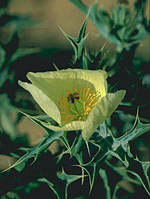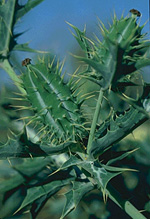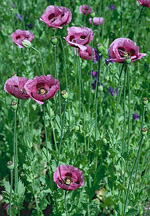 |
No species of the poppy family are native to Australia, this being principally a northern-temperate family. Several introduced species are weeds of disturbed sites such as roadsides and cultivation, particularly in drier, semi-arid temperate regions.
Characteristic features of the family Papaveraceae in Australia include: - annual or perennial herbs often with bristly stems and milky latex
- leaves alternate, often more or less rosetted at the base of the plant, lobed or deeply and irregularly dissected, sometimes spiny
- flowers usually large and showy, solitary, often on long stalks
- sepals 2, often fused into a cap which falls as the four crepe-like, white, yellow, pink, orange or red petals expand
- stamens numerous
- fruit a capsule, opening by terminal slits or pores to release the fine seeds
Description
Deciduous shrubs, or annual, biennial or perennial terrestrial herbs. Perennating by rhizomes, taproots or crowns. Vegetative reproduction absent, or by rhizomes. Stem internodes solid or hollow. Internal secretions not obvious or of milky sap (latex) or coloured sap. Plants glabrous, or with simple, glandular or non-glandular, unicellular, uniseriate or multiseriate hairs. Leaves alternate and spiral, cauline or both basal and cauline if herbs, petiolate, subsessile or sessile. Stipules absent. Lamina simple, symmetric, pinnatifid or pinnatisect or bipinnatifid or tripinnatifid, etc, lanceolate or ovate; base cuneate, attenuate or cordate; margins entire, crenate or dentate, ±flat; venation pinnate, with the midrib conspicuous or inconspicuous, and the tertiary venation not reticulate; surfaces not punctate; herbaceous. All the flowers bisexual. Inflorescences terminal or axillary, consisting of cymes or solitary flowers. Bracts present. Pollination by insects. Flowers odourless or fragrant, stalked. Perianth regular, of 2 dissimilar whorls. Calyptra absent or apparently present. Calyx segments free, with 2–3 (–4) sepals, imbricate in bud, herbaceous, usually falling early. Corolla segments free, with 4–6 petals, alternating with or opposite the sepals, imbricate, plicate or crumpled in bud, white, cream, yellow, orange, red, pink, magenta, purple or violet, without contrasting markings, or streaked, spotted, etc, membranous; claws absent; lobes ±entire. Fertile stamens numerous, not clearly correlated with the sepals, free or at least partly fused to the corolla, free of the ovary and style, distinct from each other, all ±equal. Anthers basifixed, not versatile, opening outwards by longitudinal slits, 2-celled. Ovary superior and sessile. Carpels 2–12, fused; ovary with 1–12 locules. Style terminal, single and unbranched, or absent with the stigma ±sessile on the ovary and capitate or radiate-peltate. Ovules numerous per locule, stalked; placentation parietal. Fruit a dry, dehiscent valvular, poricidal or loculicidal capsule sometimes with explosive dehiscence; the perianth on the maturing fruit deciduous. Disseminule micro-surface ±reticulate, white, blue, brown, grey or black, glossy or dull. Seeds numerous per fruit. Aril present or absent. Cotyledons 2. Embryo straight or curved.
(Note: this description has been generated from the coded data compiled for the key. Any errors in the key data will be reflected in the descriptions.)
A treatment of the family Papaveraceae has not yet been published in the Flora of Australia. It will appear in Volume 2.
Australian genera of Papaveraceae (as recognised for the Flora of Australia)
* = all species introduced
*Argemone
*Eschscholtzia
*Glaucium
*Papaver
*Roemeria
*Romneya

|
  |

Argemone ochroleuca ssp. ochroleuca (flower)
Photo: B.Thomson © Parks & Wildlife Commission of NT

Argemone ochroleuca ssp. ochroleuca (fruits)
Photo: B.Thomson © Parks & Wildlife Commission of NT

Papaver somniferum ssp. setigerum (flowers)
Photo: M.Fagg © ANBG
|
 |
|